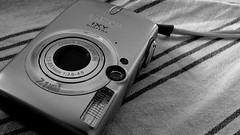Monday, January 23, 2006
Digital cameras: silicon and pixels
Digital Camera Basics
From Peter Marshall, About.com / Photography.
Cells and Pixels:
In digital cameras the light-sensitive medium is a silicon chip covered with a regular pattern of very small light sensitive circuits.
When a few photons hits one of these it causes a few electrons to flow in a circuit. These electrical signals are then amplified and converted into a digital format.
Each cell in most sensors is covered by a red, green or blue filter (RGB), so that only light of that colour can reach it. The 'raw' image that contains the digital values for these separate RGB sites is then mathematically converted into pixels - values for red green and blue at a particular point.
Pixel count alone gives a poor idea of a camera's capabilities.
Many images used professionally have been taken on cameras with only 2-3 Megapixels. A greater number of pixels will not improve image quality if the information they provide is less reliable. A 5mp or 6mp camera should be able to produce decent prints at up to A3 size.
Sensor size
Consumer cameras use small sensors, only a few millimetres in each dimension, making the individual pixels very small. Professional cameras use larger sensors - so that the individual cells are perhaps 5-10 times the area and are also better separated. The larger cells capture more light for the same exposure, giving electrical signals that need less amplification and have less random noise (fuzziness).
Subscribe to:
Post Comments (Atom)


No comments:
Post a Comment